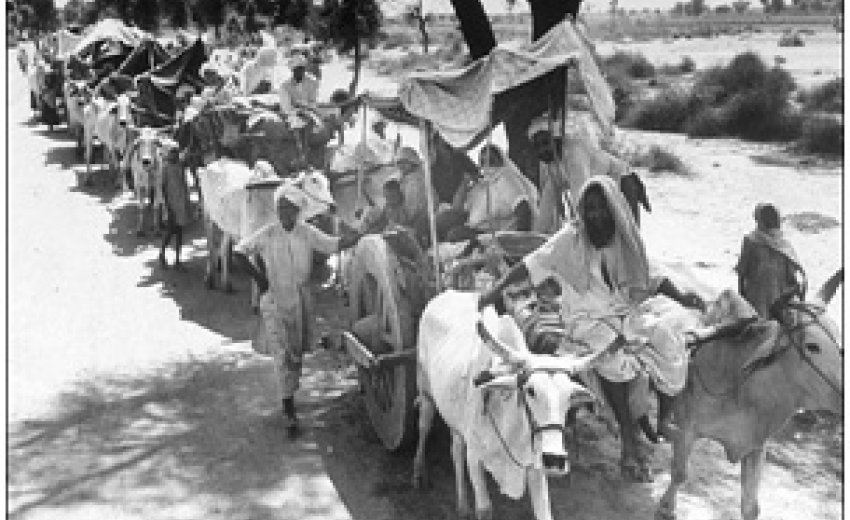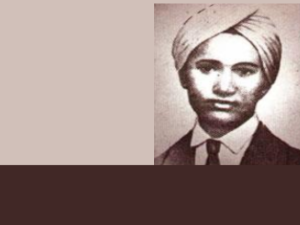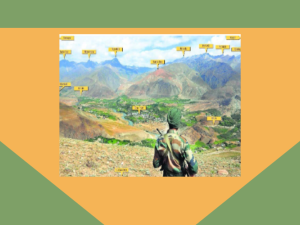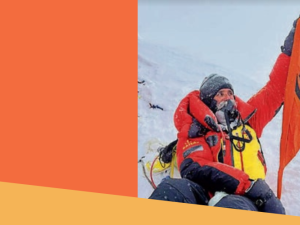Refugees are the ones who are displaced from one place and migrate to other for settlement. We had earlier become refugees shifting from our ancestor village Rattan; to the new village 89JB Rattan. Now the situation took a different turn. We were to shift from 89JB Rattan to an unknown location. This is a painful story.
The violent activities started at border areas of Western India (now Pakistan) and in Bengal areas in March 1947 and soon engulfed the entire Punjab and Bengal by August 1947 like a wild fire. Since the Sikhs in the region had developed into prosperous farmers; the fate took different turn for them. All the Bars; Ganji Bar, Sandal Bar, Dule di Bar (Jhana di Bar), Nili Bar; to say a few were the most affected. Dule di Bar; the most prosperous Bar also known as Jhana di Barkat due to its irrigation from the canal from river Chenab; was soon a hell for those who had made it a heaven. The political and religious fanatics started war cries for division of India. The British agreed to accede as they wished that both Hindus and Muslims would never reconcile and there were regular in-fights. As a result Hindu and Muslim leaders agreed for partitioning India.
Stephens declares it as a civil war and writes: "If about 5,00,000 deaths due to disturbance and bloodshed cannot be termed as Civil war then what else." Bresher calls it war of inheritance. Tinker declares it's people's war. No one however can deny that it was a communal war. Some call it an ethnic cleansing. These disturbances started since March 1947 and Punjab was declared disturbed area under Punjab Disturbed Area Act 1947 and Punjab Public Safety Ordinance was issued. Sialkot, Gurjranwala, Sheikhupura, Lyallpur, Mintgumri, Lahore, Amritsar, Gurdaspur, Hoshiarpur Jalandher, Ferozepur and Ludhiana were declared riot affected areas. Army was frequently called to quell the disturbances. In his letter no 9418 dated 26 July 1947, the Home Secretary Punjab gave the casualties in Multan and Rawalpindi alone as under:
| District | Killed or burnt alive | ||||
| Hindu | Sikh | Muslims | Others | Total | |
| Multan | 171 | 1 | 14 | -- | 186 |
| Rawalpindi | 2663 | -- | 38 | -- | 2701 |
| Injured | |||||
| Hindu | Sikh | Muslims | Others | Total | |
| Multan | 87 | 2 | 59 | 19 | 167 |
| Rawalindi | 234 | -- | 126 | -- | 360 |
| Properties burnt | |||||
| Multan | 20,00,000 | ||||
| Rawalpindi | 14,00,000 | ||||
Deputy Commissioner Rawalpindi said: "It is not possible to give correct statistics, because the administration failed totally due to heavy riots. The above figures are the least ones as per the police reports". Governor of Punjab Sir Even Jenkins expected a civil war. Malcolm Darling a visitor to Punjab in April 1947 found that the state was burning like a volcano. According to an inquiry (Mamdot Inquiry October 1949) Muslim League purchased lot of war material which they used against Hindus and Sikhs. According to Lord Imme, Sikhs in India were around 5.5 million out of which only 4 million were in Punjab. After partition 2 million of Western Punjab migrated to East Punjab and other surrounding areas leaving behind half of their religious places in Pakistan.
The partition of India into Pakistan and India took place in 1947, on 14 and 15 August, respectively as set forth in the Indian Independence Act 1947. The partition was based on the Radcliffe Boundary Commission which was deliberately delayed to be announced for two days by Lord Mountbatten. The award by the commission had a poor structure. Partition of the Punjab province became West Punjab (later the Pakistani Punjab and Islamabad Capital Territory and East Punjab (later the Indian Punjab, as well as Haryana and Himachal Pradesh). The partition agreement also included the division of Indian government assets, including the Indian Civil Service, the Indian Army, the Royal Indian Navy, the Indian Railways and the central treasury, and other administrative services. The British sent the British soldiers back to Britain just before partition fully measuring the catastrophic situation. The divided Indian Army and police force of the state were still very confused about the command and control systems.
The riots spread to the entire Punjab in August 1947. Situation was getting worsened day by day. Muslim League and Rashtriya Sawaym Sangh were stated to be leading in creating a communal tension and were in favour of ethnic cleansing. The fanatics and free-booters from both sides took the advantage of the confusion and created mayhem. It resulted in a struggle between the new states of India and Pakistan and displaced up to 12.5 million people in the former British Indian Empire, with estimates of loss of life varying from several hundred thousand to a million (most estimates of the numbers of people who crossed the boundaries between India and Pakistan in 1947 range between 10 and 12 million). The violent nature of the partition created an atmosphere of mutual hostility and suspicion between India and Pakistan that plagues their relationship to this day.
As the situation deteriorated, the villagers in Lyallpur district were alarmed too. They started getting threats from Muslim fanatics. There were attacks, killing, looting and putting the houses to fire in neighbouring villages. Stories of these heinous incidences kept on pouring. As a result on September 4, 1947, the villagers of Rattan and Dhaipai decided to evacuate in a caravan (Qafila) because that day a train arrived from India at Gojra which had badly injured and even dead bodies of Muslims. This had infuriated the local Muslims and war-calls started from all over. The only source of conveyance of the luggage was the carts and the travel had to be by foot as the Government made no plans for their evacuation. Those who did not have carts have to throw away their property and take minimum essentials on their heads. The movement had to be in groups and the teams of protectors had to be detailed for self protection since sufficient and relaible protection from Army or police was not available. The movement was to be in stages; camping en-route at protected sites. Only the essentials especially the food and clothing could be carried and the heavy luggage as well animals had to be left behind.
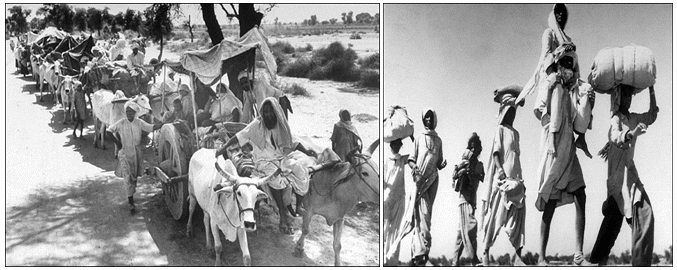
Villagers migrating on carts and on foot from West Punjab to east Punjab
Since my father had no cart of his own; he had to manage it from somewhere; otherwise going on foot for such a long distance in such trying circumstances with his three siblings was extremely difficult. Requirement was of carrying food and clothing for the family for some days as the life at other end was like a dark tunnel. However in those dark days; there were people to help as well. All the scattered family members were to be brought together before start. My maternal cousin Naseeb Kaur, who was recently married on 23 February 1947 to S. Hari Singh of our village in the milieu was in my maternal home 338 Chak JB Rajewal. To bring her, her husband Hari Singh, Karam Singh and a Muslim Sadiq Ali moved on a cart with my father on 4 October 1947. Since the people from 338 JB had already moved out of the village, the requirement was to search them out in the advancing columns.
Since road travel was not safe they had to move in a caravan of refugees moving back to Eastern Punjab now part of India. First stop of the caravan was at Tobha Tek Singh. They stayed for the night where the local Sikhs had made some adhoc arrangements. Many young girls were hurriedly married at Tobha Tek Singh in a mass marriage ceremony. Here by night, Sikhs from other neighbouring villages also joined and the strength of the caravan increased. The caravan started early in the morning. By now the local Muslim fanatics had gathered and started attacking on whosoever lagged behind or went out of the caravan. To protect the caravan; a group of young Sikhs with rifles on horses was formed who kept moving along the caravan and protected from the flanks; front and rear. The next night stay i.e., on 5 September was at Nagra.
The caravan started early at 3 AM from Nagra on 6th. Government had ordered closer of all water channels in the region since the fanatics were killing Sikhs and Hindus and throwing them into the water. Such a state had come that the dead bodies choked these sources of water and water started spilling over. There was no Army or Police for protection. Everyone was required to fend himself. It was a virtual jungle raj. The caravan moved on; stopped only at night near Jarneewale. It was a tedious journey for 14 hours non-stop without having food since last evening. Almost all the men and most of the women had walked along hungry since carts had luggage, the children and the sick. Overall situation was pathetic but there was no one to console since all were affected. The fear of the Muslim fanatics kept on mounting further. The next day was even worst. Starting early morning again on Samundri-Gojra road they camped next in the open for the night in Jallianwale village. On 9th October, they traced my maternal uncles' cart and collected Naseeb Kaur and returned to village Rattan. Moving back from village Jallianwal to Rattan 89 JB was too dangerous since they were moving alone. They moved on a different route through Seetla 475 JB. En-route at a station Pakka Anna they saw a train from India full of injured Muslims. It became clear in their mind that they had to run against time and it was better for them to leave their village Rattan as earlier as possible.
As they reached Rattan on 10th night, all their village folks had packed their luggage and got their carts ready to move. They were to join with others at Dhaipai. The entire village was explained about the situation around and alerted to be better prepared and cautioned to be vigilant during move. Safety of life was more important than property. Aim was to cross over to the newly formed India. 10th September was the day of loading. Since our family had no cart of our own, my maternal cousin brother Arjan Singh had arranged a cart from his village and the luggage was hurriedly loaded. Since only a part could be loaded the remaining was left behind as it is. The cows and buffaloes were freed. On 11th , the village formed into a caravan and moved in the evening at 3 PM for Dhaipai. The entire Sikh and Hindu population leaving 3 families of Muslims left the village en-mass. It was not easy leaving. Most of the younger generation had been brought up at the place and had sweet memories attached. The elder men and women had built the village brick by brick and had all the heart in the village. Caravan of village Rattan reached 84JB Dhaipai to form part of a bigger caravan. Caravans of Dhaipai, Kotli, Heer, Leel and Dhaulmajra also joined along at 84 JB., This large caravan left 84JB next day early morning on 12th and reached Theekriwala canal rest house area same evening. They camped along the canal. They had the fodder for their oxen from the fields and used their own grain for cooking food. Water was however a problem as the canal nearby was full of dead bodies and the water was polluted. Local pumps and wells were exploited however by the groups from the caravan even though some wells too were polluted by the dead bodies. Children were the first to get affected by Diarrhea followed by elderly week.
Next day early the caravan prepared to move but the orders from the DC came for it not to move. No one however agreed to stop as the inside information was that the caravan was being stopped to give a full hand for the Muslim fanatics to butcher the caravan. Young Sikhs had made protected teams on horses and with rifles and swords or whatever they could lay hand on. My younger brother Daljit and my cousin brother Jarnail Singh along with many other children in the caravan were affected by Diarrhea and jaundice due to use of polluted water. It was also rumour that the local sources of water were also poisoned. Health of Daljit and Jarnail soon deteriorated but there were no doctors or any medical aid available from any source. Father managed to go to nearby village Sudhar and showed both the sick to a village doctor who gave some medicine and advised not to fall out from the caravan since the plans of the Muslim fanatics were to eliminate all. I was too young (only three years) to understand the situation and was feeling too uneasy. My elder brother Gurdarshan was five then; he helped mother to keep control of both of us.
The caravan finally moved out of the Theekriwala on 12th and reached Sudhar 75 JB covering just 4 miles. My cousin Jarnail (the only son of my aunt Dalip Kaur) could not surviuve as he died at 4 PM at Sudhar on 13th September and was buried in the nearby fields without any formal ceremony. Strict instructions came for the next three days i.e., 14th, 15th and 16th to stay put at Sudhar. These three days were the days of the mourning for our family members. On Friday the 17th the caravan moved on the road to Lyallpur from milestone 9 onwards. After covering around 12 miles they camped for the night at Khalsa College Lyallpur. The water was in scarcity since all the ponds, wells and other sources of water were found poisoned. The local Sikhs helped the caravan with food and water. On vociferous and persistent demand to the DC by the caravan leaders for protection, some force consisting of Dogra and Sikh Army was provided for further journey. The caravan moved under due protection on 18th from Layallpur Khalsa College to Bangla Avagat and covered 15 miles. Next day (19th) they left Bangla Avagat at 6 AM and moved to Lundianwali where after a night stay they moved at the same time to Mangatwala covering 23 miles in two days. They had just covered ten miles from Mangatwalla a mile short of Balloki Head when they were attacked by Muslim fanatics. They fired intermittently on the caravan. As a result Pandit Ram Chand of our village was killed. The Dogra soldiers retaliated. Seeing the Army in action the Muslim fanatics withdrew. Pandit Ram Chand had to be buried in the open field without any ritual; the burial the Pandit would have least wanted.
As the caravan started crossing Balloki Head the water of the canal was an attraction for all. It was not drinkable however because it was full of bodies. Still most of the thirsty quenched their thirst from this polluted water. This however became the cause of diarrhea since number of people died of this en-route later. Crossing Balloki Head, they crossed River Ravi and camped other side of the river. Since the caravan felt too unsafe; the Army arranged some trucks for conveyance of the old; ladies, children and the sick. The young boys and girls were intermarried without caring for the inter-caste and inter gotra systems. Hindus and Sikhs married without considering anything accept age. Since none had been left with any wealth; so barrier of wealth had gone. There were no other rituals; no dowry etc but reading of Anand Karj and having four circles around Sri Guru Granrth Sahib; the system common for all marriages. No one knew when he would die and when he would depart from the caravan. Everyone was scared of the increasing war cries and fires burning in the villages around. Families thought these marriages as the best alternative to save the izzat of the communities. Women were even asked to wear kirpans. In case of any attack, they were supposed to counter-attack to kill. If not possible to do so they were to kill themselves with the kirpan. This kirpan became a common weapon for Sikhs and Hindu girls. It was a do or die business. Since safety and security was the key problem; the caste barriers all blew in the air. Relationship of Hindus and Sikhs was thus bonded permanently.
From Mangatwalla the next stay was at Feru; which they left on 22nd and reached Manga covering 15 miles. Since water remained short, the rivulet bed was dug to take out water. The soldiers had by now started feeling as the party of the community problem and helped them in every way. Providing this water solution was also the innovation of a military mind. Next day on 23th; leaving Manga and crossing through Raewind covering 15 miles, they had the next camp at Rakhanwala. Since the border appeared close, the spirit of the caravan rose. Next day on 24th they started early from Rakhanwala and covering another 15 miles crossing Kasur reached Khemkaran. It was an auspicious day: Dussehra; the birth day of my elder brother but nobody ever thought of birthdays or auspicious days as all days were horrible for them.
Though there was no formal boundary as is seen these days but crossing over to New India from Old India was a matter to rejoice. Everyone was relieved at the thought that they were no more in the danger zone. However the tragedies had been continuously mounting. As the caravan was just to cross the border, my cousin Avtar Singh son of Sardar Sajjan Singh died of diarrhea on 25th. He too was buried in the open without any ritual. The entire family was in mourning but still thanked God that He has brought us safe from a hell. What was in store for future was not known. Their lands, animals and other valuables all were left behind. They had lost number of near and dear ones en-route. At Khemkaran, the volunteers helped them with food and medicine and they were injected for diarrhea and other diseases. Those who were sick were treated. However a new name 'Refugee' was attached by the volunteers from new India. This name remained permanently attached till the older generation was replaced by the new. I am grateful to my father who kept all these records in his diary which helped me to produce these accounts.
In pictures: India's Partition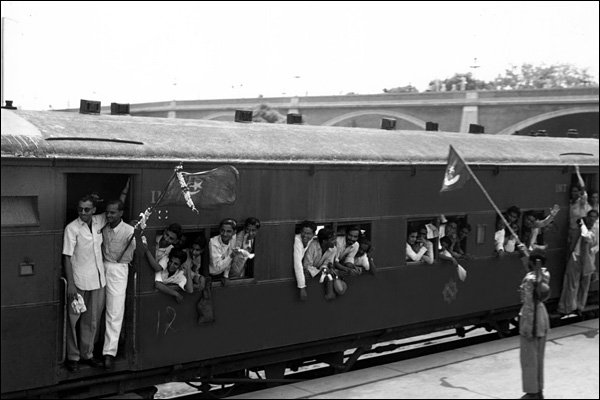 |
| more |
| Courtesy: BBC News |
